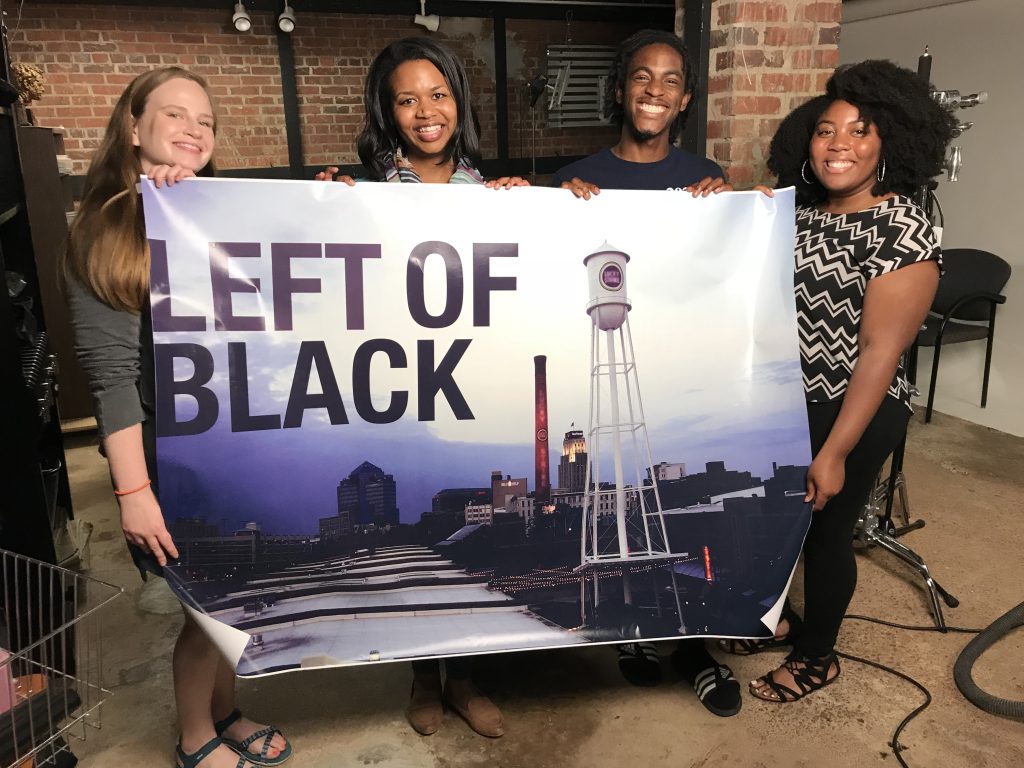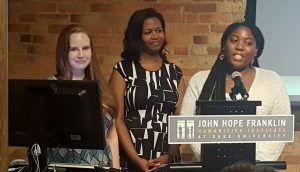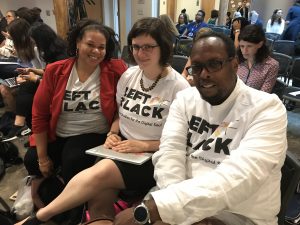Home » Posts tagged 'left of black'
Tag Archives: left of black
Black Studies All Up In Your Classroom: Students Create Online Curriculum

Find the stories. Make lesson plans. Put it online.
That’s what a team of students working for the weekly webcast Left of Black was tasked with this summer, but it wasn’t so simple. The webcast showcasing scholars, artists, musicians, just completed its 8th season. That meant there were nearly 250 videos and guest interviews to sort through, many of which hadn’t been in circulation since they first aired years ago.
With funding from Story+, a 6-week summer research program in the Franklin Humanities Institute (FHI), the students, two graduate and two undergraduate, set out to accomplish the mission. Using their respective skills of creating lesson plans, video editing, website building and some acquired new skills, they found interesting stories in the Left of Black archive and turned them into online teaching modules for middle- and high-school students.
The enrichment modules include a video clip derived from a Left of Black episode, a lesson plan and a “digital student experience,” as well as supplemental reading. The Story+ Left of Black team exceeded their initial goal of creating two modules — the team was able to produce four — and made their final presentation at a FHI research symposium on Wednesday, June 27 at Smith Warehouse.

The themes covered in the modules are: service and citizenship, the cultural significance of Black barbershops, the role of music in the Black Power Movement, and Black armed resistance. Each module includes discussion questions, timelines, vocabulary and further reading and is in alignment with the state’s common core standards. The digital experiences and lesson plans can be accessed online here: https://sites.duke.edu/leftofblackenrichment.
Duke undergraduates Ce’Ondra Ellison and Malcolm Brown had both taken classes in Duke’s Department of African & African American Studies and were passionate about what themes and characters they might find.
“This information is so lacking,” said Ellison, an African-American Studies major from High Point, N.C. “I am hoping this work will have long-lasting impact on education.”
Brown was enthusiastic about the project, and quickly grasped the technical aspects of the project like animating a grandmother for a video clip about Black armed resistance.
Graduate students Allison Raven and Nicole Higgins each had prior experience teaching in classrooms and creating lesson plans.
The Story+ experience “allowed me to stay connected to work I had been doing before with high school teachers, which is easy to lose in academia,” Higgins said.
Raven agreed.
“I think we have been extraordinarily lucky with our team. None of us knew each other before beginning the project. For something that relies so heavily on teamwork, this could have gone really badly, but we all balance each other really well and work well together. And I loved the collaborative aspect,” Raven said.

As a team, Raven said they gained a deeper understanding of how to tell stories in the digital age and which tools to use, including social media. The team won FHI’s Story+ Instagram challenge.
FHI’s Chris Chia, Amanda Starling Gould, and Eric Barstow, provided infrastructure and guidance as the Left of Black team delved into the archive and selected a WordPress template on which to build the website.
Left of Black host Mark Anthony Neal, who is also the chair of African & African American Studies at Duke, helped the students select four episodes in which to focus their efforts:
- Quincy T. Mills, a history professor at Vassar College and author of “Cutting Along the Color Line: Black Barbers and Barber Shops in America”;
- Chad L. Williams, chair of the African American Studies Department at Brandeis who wrote, “Torchbearers of Democracy: African American Soldiers in the WWI Era”;
- Ricky Vincent, author of “Party Music: The Inside Story of the Black Panthers’ Band and How Black Power Transformed Soul Music”; and
- Akinyele Umoja, an associate professor of African-American Studies at Georgia State who wrote, “We Will Shoot Back: Armed Resistance in the Mississippi Freedom Movement.”
The students took excerpts of these videos and used graphics and animations to produce enrichment videos like this one:
First started in 2010, Left of Black is now entering its 9th season. Neal has interviewed a number of notable scholars over the years including Carrie Mae Weems, Cornel West, Michael Eric Dyson, Marc Lamont Hill and Melissa Harris Perry. There are plans to continue building the Left of Black curriculum and digital platform.
“It has reinvigorated the project for me,” Neal said. “It’s something we had envisioned from earliest days of Left of Black and we were thrilled to have a team of students to help us realize that vision. It serves as model for what integrated learning could look like, not just at Duke but in the production of scholarship for a broader audience.”

#Oscars(Not?)SoWhite: The State of Black Hollywood
Record-Setting Year For Black Actors/Films Nominated for the 2017 Academy Awards

Setting a new record this year, the Academy Awards announced the nomination of six black actors with diverse films such as Moonlight, Fences and Hidden Figures in the running for best picture. The nominations may, at least partially, be in response to protests in recent years that the Oscars routinely snub black talent, sparking the hashtag, #OscarsSoWhite.

“I want to know whether it’s a moment, or a real transformation of Hollywood,” said Stephane Dunn, an associate professor and director of the Cinema, Television and Emerging Media Studies program (CTEMS) at Morehouse College. “These are really great films. In another year, several of them would be all but ignored.”
Dunn will join Natalie Bullock Brown, a professor of film and broadcast media at Saint Augustine’s University, and Mark Anthony Neal, a professor of African and African American Studies at Duke, for a talk, “#OscarsBlackAF?: The State of Black Hollywood.”
The event, free and open to the public, will be a live taping of Neal’s weekly webcast, Left of Black. It will be held at 6:30 p.m., Thursday, Feb. 9, in the Ahmadieh Family Conference Hall (Room 240) at the John Hope Franklin Center (2204 Erwin Road).
Dunn said she has a love/hate relationship with the Oscars which will be televised on Feb. 26.

“I have never watched [the Academy Awards] from beginning to end because it’s been such a white space,” Dunn said. “If this is truly a transformative moment, how do we support and sustain so that nominations of talented black actors and great black films become normal and not an anomaly?”
“I’m honestly very excited to see all the blackness and I think absolutely very single nomination is deserved,” Bullock Brown said. “When I saw Fences and Moonlight, I thought, if they don’t get nominated, I don’t even know what to say.”
Bullock Brown remains skeptical that the online hashtag protests and criticism by the Rev. Al Sharpton about the lack of diversity in Hollywood had any effect on the record setting nominations this year.
“I don’t think Hollywood is paying us one bit of attention. I don’t think they care about a hashtag,” she said. Yet, she added, Hollywood likes to see itself as very progressive.
“I wonder whether these types of nominations would have happened in the numbers that they did this year if it weren’t for the fact of our new administration. Trump has made white people a lot more conscious of some of their choices,” Bullock Brown said. “I refuse to believe that suddenly our work is of a caliber that deserves recognition.”





